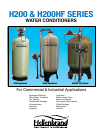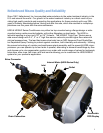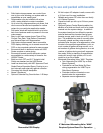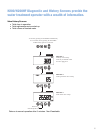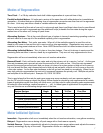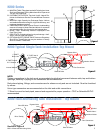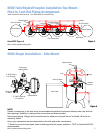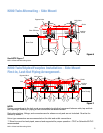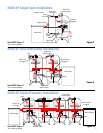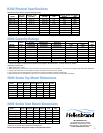
Modes of Regeneration
Time Clock - 7 or 28 day calendar clock shall initiate regeneration at a pre-set time of day.
Parallel Individual Meters - All units are in service at the same time with either delayed or immediate re-
generation. A lockout feature or offsetting time of regeneration prevents more than one unit to regenerate
at a time. Units may use either a xed or variable reserve for operation.
This is used where the ow rate of one unit is not enough and there is sufcient down time for conditioned
water to allow one unit to regenerate and the additional unit(s) to handle the ow rates during the regen-
eration time of the other unit, during off peak times.
Alternating Systems - This is the most efcient type of system in terms of maximizing operating costs for
salt and water as it uses up all of the available capacity prior to regeneration.
Alternating One Meter - Twin units, one meter. When all of the available capacity is used the unit on
stand-by will come on line and the unit in service will go into regeneration. Regeneration may occur im-
mediate or during preset windows of time. Note: H200 Series have built-in internal meters on each unit.
Alternating Individual Meters - Twin, tri-plex or four-plex designs. One unit is always in service and the
remaining units are either in service, stand-by or regeneration. Only one unit may regenerate at a time.
Regeneration will occur immediately when one unit reaches exhaustion.
Demand Recall - Each unit has its own meter and only the primary unit is in service "on line". As the gpm
ow rate increases past a pre-set set point the second unit will come on line. If the ow rate increases
beyond the second pre-set set point and you have a tri-plex or four-plex system a third unit will come on
line, and should the ow rate increase beyond a third pre-set set point a fourth unit will come on line with
a four-plex system. As the ow rate decreases, units will go back on stand-by accordingly. When the pri-
mary unit goes into regeneration the next unit in sequence becomes the primary unit. Multiple set-points
are multiples of the rst set point. Example: 50, 100 & 150 GPM.
This is used where the ow rate for peak gpm usage may occur randomly such as a process applica-
tion for CIP at shift change or where the supply xture counts for plumbing code requirements for certain
types of applications more than likely will never occur, yet they need to meet plumbing code requirements
for schools, ofce buildings, medical complex's . . . etc. In these types of applications the system may
very well function as an alternating design most of the time.
System Designs Single Twin Tri-Plex Four-Plex
Time Clock X X X X
Variable Reserve X X X X
Parallel, Individual Meters X X X
Demand Recall X X X
Alternating, One Meter X
Alternating Individual Meters
X X X
Meter Initiated Options:
Immediate - Regeneration shall occur immediately when the unit reaches exhaustion, zero gallons remaining
.
Delayed - Regeneration occurs during off peak usage with a xed reserve capacity
Variable Reserve - System automatically adjusts to changing water usage patterns and adjusts the reserve
capacity accordingly by day of the week. Regeneration occurs on a delayed basis.
7



